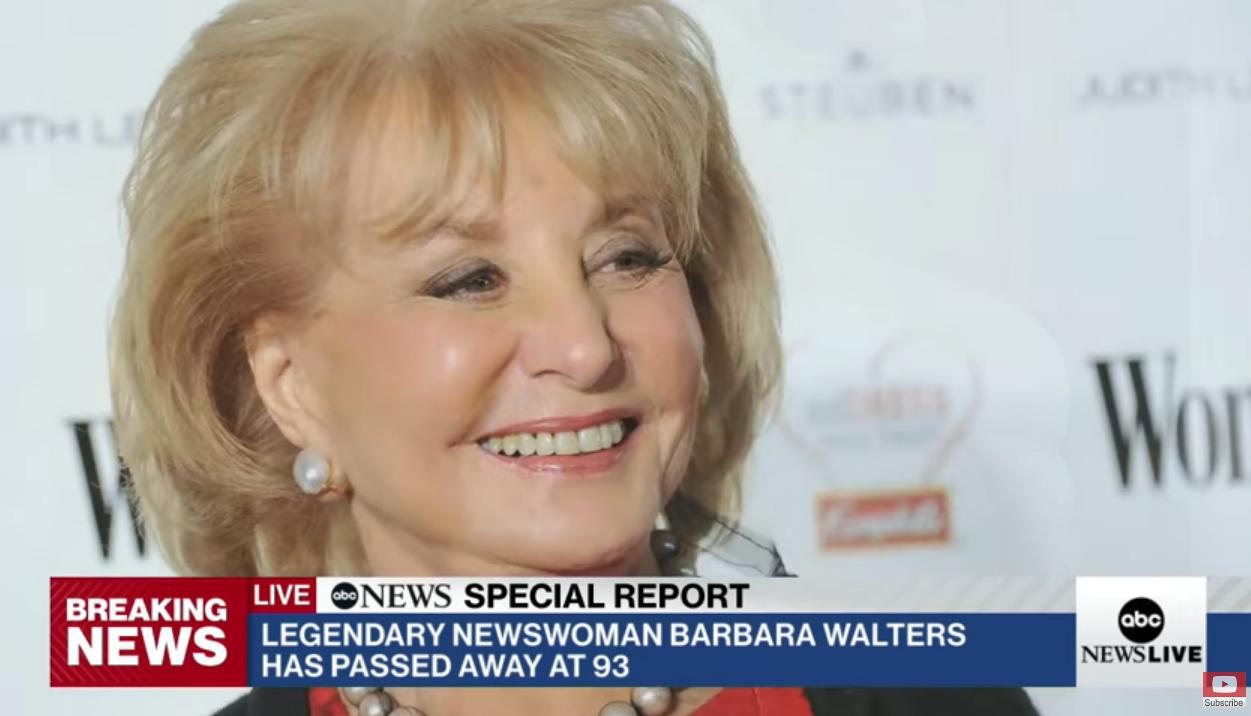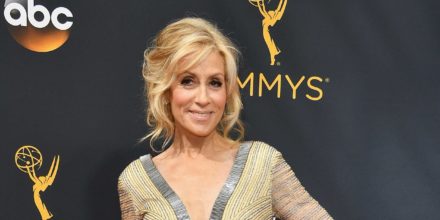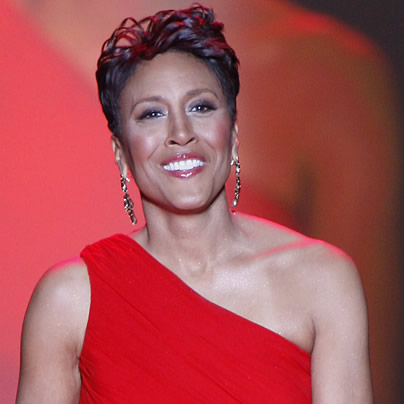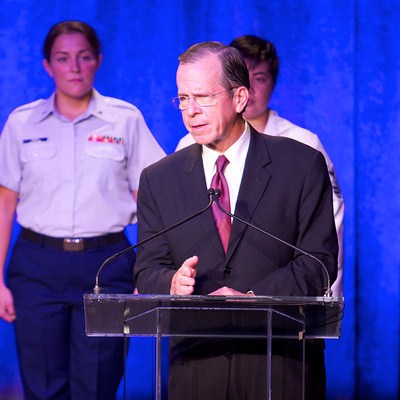National
Barbara Walters dies at 93
Groundbreaking journalist interviewed Jazz Jennings, Ellen DeGeneres, among others

If ever there was a gold standard for American broadcast journalists the likely two top choices would be famed CBS reporter and anchor Walter Cronkite and the groundbreaking ABC News reporter and anchor Barbara Walters.
The news came late Friday that the latter, a legendary broadcast journalist had died peacefully surrounded by family and friends at her home in New York at age 93. Walters shattered the glass ceiling in her profession and became a dominant force in an industry once dominated by men. Walters is survived by her adopted daughter Jacqueline.
Without a doubt Walters likely holds a record for the shear number of interviews of the rich and famous, political leaders, as well as celebrities from every walk of life and endeavor. Walters, who won 12 Emmy awards, 11 of those while at ABC News was inducted into the Television Hall of Fame in 1989.
In her 50-plus year career as a broadcast journalist she had earned nearly universal acclaim, respect and admiration for her work.
At ABC News as the co-anchor of the network’s extremely successful award winning “20/20,” she interviewed the people who made history in the mid 20th century into the early 21st century conducting her last interview, of then-businessman and potential presidential candidate Donald Trump, in 2015.
Walters began her national broadcast career on NBC’s “Today” show as a reporter, writer and panel member before being promoted to co-host in 1974. Her rising popularity with viewers resulted in Walters receiving more airtime, and in 1974, NBC executives promoted her to be the co-host of the program, the first woman ever to hold such a title on an American news program
Walters joined ABC News in 1976 after, becoming the first female anchor on an evening news program. Three years later, she became a co-host of “20/20,” and in 1997, she launched “The View.”
Bob Iger, the CEO of the Walt Disney Company, which is the parent company of ABC News, praised Walters as someone who broke down barriers.
“Barbara was a true legend, a pioneer not just for women in journalism but for journalism itself. She was a one-of-a-kind reporter who landed many of the most important interviews of our time, from heads of state to the biggest celebrities and sports icons. I had the pleasure of calling Barbara a colleague for more than three decades, but more importantly, I was able to call her a dear friend. She will be missed by all of us at The Walt Disney Company, and we send our deepest condolences to her daughter, Jacqueline,” Iger said in a statement Friday.
She made her final appearance as a co-host of “The View” in 2014, but remained an executive producer of the show and continued to do some interviews and specials for ABC News.
“I do not want to appear on another program or climb another mountain,” she said at the time. “I want instead to sit on a sunny field and admire the very gifted women — and OK, some men too — who will be taking my place.”
From American presidents to her famed interview with Egyptian President Anwar Sadat, along the way Walters touched on the lives of diverse and dynamic cross-section of humanity.
Her face to face conversations included face-to-face conversations with folks like actors Katharine Hepburn, John Wayne, Patrick Swayze, Fred Astaire. She spoke with musicians such as Michael Jackson, Justin Bieber, Barbra Streisand and, without missing a beat, the significant political figures of her day like Henry Kissinger, California Gov. Arnold Schwarzenegger, Vladimir Putin and Fidel Castro. Her interviews with Oprah Winfrey and Monica Lewinsky shot the network’s ratings audiences through the roof.
The New York Times reported in 1999 that Walters’ interview with Lewinsky, the former White House intern who was a key component in the impeachment trial of then President Bill Clinton, “attracted an average of 48.5 million viewers, and an estimated 70 million people watched all or part of the two-hour program, in about 33.2 million homes.”
Walters directly asked Lewinsky, “You showed the president your thong underwear. Where did you get the nerve? I mean — who does that?” she said. She also asked the 25-year-old: “Where was your self-respect, where was your self-esteem?”
The list of people in front of the camera with her on the “Barbara Walters Specials” was breathtaking. Yet the stories of everyday folks, their lives, and struggles were a staple of her work searching out stories that needed to be told.
For the LGBTQ community, Walters often told the stories that painted a picture that was critical in putting a human face on an oft times maligned community. Her ABC documentary on transgender children originally broadcast in 2007, introduced the world to trans girl Jazz Jennings, who was at six years of age at the time, and her hugely supportive family.
The Hollywood Reporter noted in an honest interview, Ellen DeGeneres talked to Walters about everything from her movie career to her decision to come out as a lesbian. She also opened up about her stepfather sexually abusing her and how she broke through a window one night to get away.
Walters in later years did have her share of detractors among younger journalists and writers including Alex Pareene, the former editor-in-chief of online news site Gawker and later a staff writer at The New Republic in 2019.
Pareene penned an unflattering profile of Walters on May 13, 2013, in Salon headlined “Good riddance, Barbara Walters.”
He noted: “[…] current co-host of ‘The View,’ is a national icon and a pioneer, and probably as responsible as any other living person for the ridiculous and sorry state of American television journalism. She has announced her retirement a year in advance, so that a series of aggrandizing specials can be produced celebrating her long and storied career. So let’s get things started off right, by reminding everyone how her entire public life has been an extended exercise in sycophancy and unalloyed power worship.
Pareene also took aim at her relationship with “Roy Cohn, the notorious scumbag McCarthyite mob attorney.”
Writing about the relationship between the two Pareene notes: […] “she, legendarily, pretended to be seeing (romantically) Roy Cohn, the notorious scumbag McCarthyite mob attorney who was also, notoriously, a closeted gay man (who had persecuted closeted ‘deviants’ while working with McCarthy.) Cohn was one of the slimiest and most detestable characters of the entire 20th century.
He was finally disbarred, in part for his hospital visit to a dying and incapacitated millionaire in which Cohn held up the man’s hand and had him ‘sign’ a codicil to his will naming Cohn the trustee of his estate. Despite his moral bankruptcy, Cohn remained a member of elite Washington and New York society his entire life.
Walters said she was and remained close to him because he helped her father with a legal matter when she was a girl. But this also seems to explain why they were ‘dating’ in the 1950s.”
Did Cohn have a secret ‘nice’ side? She was asked.
“I would not use the word nice,” she laughs. “He was very smart. And funny. And, at the time, seemed to know everyone in New York. He was very friendly with the cardinal, he was very friendly with the most famous columnist in New York, Walter Winchell, he had a lot of extremely powerful friends.”
Barbara Walters dies at 93 l ABC News
The White House
Empty seats, canceled shows plague Kennedy Center ahead of Trump renaming
It would take an act of Congress to officially rename the historic music venue, despite the Trump-appointed board’s decision.

The board of the Kennedy Center in Washington, D.C., voted to rename it the Trump-Kennedy Center, according to the White House Press Office.
White House Press Secretary Karoline Leavitt announced the decision in a post on X Thursday, thanking the president for his work on the cultural center “not only from the standpoint of its reconstruction, but also financially, and its reputation.”
Speaking to reporters later that day at the White House, Trump said he was “surprised” and “honored” by the board’s vote.
“This was brought up by one of the very distinguished board members, and they voted on it, and there’s a lot of board members, and they voted unanimously. So I was very honored,” he said.
Earlier this year, GOP Rep. Mike Simpson of Idaho introduced an amendment that would have renamed the building after first lady Melania Trump, later saying she had not been aware of his efforts prior to the amendment’s public introduction.
Despite the board’s vote (made up of Trump-appointed loyalists), the original laws guiding the creation of the Kennedy Center during the Eisenhower, Kennedy, and Johnson administrations explicitly prohibit renaming the building. Any change to its name would require an act of Congress.
Trump has exerted increasing control over the center in recent months. In February, he abruptly fired members of the Kennedy Center’s board and installed himself as chair, writing in a Truth Social post at the time, “At my direction, we are going to make the Kennedy Center in Washington D.C., GREAT AGAIN.”
In that post, Trump specifically cited his disapproval of the center’s decision to host drag shows.
He later secured more than $250 million from the Republican-controlled Congress for renovations to the building.
Since Trump’s takeover, sales of subscription packages are said to have declined, and several touring productions — including “Hamilton” — have canceled planned runs at the venue. Rows of empty seats have also been visible in the Concert Hall during performances by the National Symphony Orchestra.
“The Kennedy Center Board has no authority to actually rename the Kennedy Center in the absence of legislative action,” House Minority Leader Hakeem Jeffries told reporters.
For decades, the Kennedy Center has hosted performances by LGBTQ artists and companies, including openly queer musicians, choreographers, and playwrights whose work helped push LGBTQ stories into the cultural mainstream. Those artists include the Gay Men’s Chorus of Washington, Harvey Fierstein, and Tennessee Williams.
In more recent years, the center has increasingly served as a space for LGBTQ visibility and acceptance, particularly through Pride-adjacent programming and partnerships.
That legacy was on display at this year’s opening production of Les Misérables, when four drag performers — Tara Hoot, Vagenesis, Mari Con Carne, and King Ricky Rosé — attended in representation of Qommittee, a volunteer network uniting drag artists to support and defend one another amid growing conservative attacks.
“We walked in together so we would have an opportunity to get a response,” said Tara Hoot, who has performed at the Kennedy Center in full drag before. “It was all applause, cheers, and whistles, and remarkably it was half empty. I think that was season ticket holders kind of making their message in a different way.”
The creation of the Kennedy Center is outlined in U.S. Code, which formally designates the institution as the John F. Kennedy Center for the Performing Arts.
As a result, it appears unlikely that Congress will come together to pass legislation allowing the historic venue to be renamed.
The White House
HHS to restrict gender-affirming care for minors
Directive stems from President Donald Trump’s Jan. 28 executive order

The U.S. Department of Health and Human Services announced Thursday that it will pursue regulatory changes that would make gender-affirming healthcare for transgender children more difficult, if not impossible, to access.
The shift in federal healthcare policy stems directly from President Donald Trump’s Jan. 28 executive order, Protecting Children From Chemical and Surgical Mutilation, which formally establishes U.S. opposition to gender-affirming care and pledges to end federal funding for such treatments.
The executive order outlines a broader effort to align HHS with the Trump–Vance administration’s policy goals and executive actions. Those actions include defunding medical institutions that provide gender-affirming care to minors by restricting federal research and education grants, withdrawing the 2022 HHS guidance supporting gender-affirming care, requiring TRICARE and federal employee health plans to exclude coverage for gender-affirming treatments for minors, and directing the Justice Department to prioritize investigations and enforcement related to such care.
HHS has claimed that gender-affirming care can “expose them [children] to irreversible damage, including infertility, impaired sexual function, diminished bone density, altered brain development, and other irreversible physiological effects.” The nation’s health organization published a report in November, saying that evidence on pediatric gender-affirming care is “very uncertain.”
The Centers for Medicare and Medicaid Services is now in the process of proposing new rules that would bar hospitals from performing what the administration describes as sex-rejecting procedures on children under age 18 as a condition of participation in Medicare and Medicaid programs. Nearly all U.S. hospitals participate in Medicare and Medicaid. HHS said that “this action is designed to ensure that the U.S. government will not be in business with organizations that intentionally or unintentionally inflict permanent harm on children.”
Health and Human Services Secretary Robert F. Kennedy Jr. released a statement alongside the announcement.
“Under my leadership, and answering President Trump’s call to action, the federal government will do everything in its power to stop unsafe, irreversible practices that put our children at risk,” Kennedy said. “This administration will protect America’s most vulnerable. Our children deserve better — and we are delivering on that promise.”
Those claims stand in direct opposition to the positions of most major medical and healthcare organizations.
The American Medical Association, the nation’s largest and most influential physician organization, has repeatedly opposed measures that restrict access to trans healthcare.
“The AMA supports public and private health insurance coverage for treatment of gender dysphoria and opposes the denial of health insurance based on sexual orientation or gender identity,” a statement on the AMA’s website reads. “Improving access to gender-affirming care is an important means of improving health outcomes for the transgender population.”
Jennifer Levi, senior director of transgender and queer rights at GLBTQ Legal Advocates and Defenders, warned the proposed changes would cause significant harm.
“Parents of transgender children want what all parents want: to see their kids thrive and get the medical care they need. But this administration is putting the government between patients and their doctors. Parents witness every day how their children benefit from this care — care backed by decades of research and endorsed by major medical associations across the country. These proposed rules are not based on medical science. They are based on politics. And if allowed to take effect will serve only to drive up medical costs, harm vulnerable children, and deny families the care their doctors say they need. These rules elevate politics over children — and that is profoundly unAmerican.”
Human Rights Campaign President Kelley Robinson echoed Levi’s sentiments.
“The Trump administration is relentless in denying health care to this country, and especially the transgender community. Families deserve the freedom to go to the doctor and get the care that they need and to have agency over the health and wellbeing of their children,” Robinson said. “But these proposed actions would put Donald Trump and RFK Jr. in those doctor’s offices, ripping health care decisions from the hands of families and putting it in the grips of the anti-LGBTQ+ fringe. Make no mistake: these rules aim to completely cut off medically necessary care from children no matter where in this country they live. It’s the Trump administration dictating who gets their prescription filled and who has their next appointment canceled altogether.
The announcement comes just days after U.S. Rep. Marjorie Taylor Greene (R-Ga.) advanced legislation in Congress that would make it a felony to provide gender-affirming care to a child.
The White House
As house Democrats release Epstein photos, Garcia continues to demand DOJ transparency
Blade this week sat down with gay House Oversight Committee ranking member

Democrats on the House Oversight Committee have released new photos from Jeffrey Epstein’s email and computer records, including images highlighting the relationship between President Donald Trump and the convicted sex offender.
Epstein, a wealthy financier, was found guilty of procuring a child for prostitution and sex trafficking, serving a 13-month prison sentence in 2008. At the time of his death in prison under mysterious circumstances, he was facing charges of sex trafficking and conspiracy to traffic minors.
Among those pictured in Epstein’s digital files are Trump, former President Bill Clinton, former Trump adviser Steve Bannon, actor and director Woody Allen, economist Larry Summers, lawyer Alan Dershowitz, entrepreneurs Richard Branson and Bill Gates, and Andrew Mountbatten-Windsor.
One photo shows Trump alongside Epstein and a woman at a Victoria’s Secret party in New York in 1997. American media outlets have published the image, while Getty Images identified the woman as model Ingrid Seynhaeve.
Oversight Committee Democrats are reviewing the full set of photos and plan to release additional images to the public in the coming days and weeks, emphasizing their commitment to protecting survivors’ identities.
With just a week left for the Justice Department to publish all files related to Epstein following the passage of the Epstein Files Transparency Act, which requires the Justice Department to release most records connected to Epstein investigations, the Washington Blade sat down with U.S. Rep. Robert Garcia (D-Calif.), the ranking member on the Oversight Committee to discuss the current push the release of more documents.
Garcia highlighted the committee’s commitment to transparency and accountability.

“We’ve said anything that we get we’re going to put out. We don’t care who is in the files … if you’ve harmed women and girls, then we’ve got to hold you accountable.”
He noted ongoing questions surrounding Trump’s relationship with Epstein, given their long history and the apparent break in friendship once Trump assumed public office.
“There’s been a lot of questions about … Donald Trump and Jeffrey Epstein. They were best friends for 10 years … met women there and girls.”
Prior to Trump’s presidency, it was widely reported that the two were friends who visited each other’s properties regularly. Additional reporting shows they socialized frequently throughout the 1990s and early 2000s, attending parties at Trump’s Mar-a-Lago resort in Florida and Epstein’s residences. Flight logs from an associate’s trial indicate Trump flew on Epstein’s private jet multiple times, and Epstein claimed Trump first had sex with his future wife, Melania Knauss, aboard the jet.
“We’ve provided evidence … [that leads to] questions about what the relationship was like between Donald Trump and Jeffrey Epstein.”
Garcia stressed the need for answers regarding the White House’s role in withholding information, questioning the sudden change in attitude toward releasing the files given Trump’s campaign promises.
“Why is the White House trying to cover this up? So if he’s not covering for himself … he’s covering up for his rich friends,” Garcia said. “Why the cover up? Who are you hiding for? I think that’s the question.”
He confirmed that Trump is definitively in the Epstein files, though the extent remains unknown, but will be uncovered soon.
“We know that Trump’s in them. Yeah, he’s been told. We know that Trump’s in them in some way. As far as the extent of it … we don’t know.”
Garcia emphasized accountability for all powerful figures implicated, regardless of financial status, political party, or personal connections.
“All these powerful men that are walking around right now … after abusing, in some cases, 14‑ and 15‑year‑old girls, they have to be held accountable,” he said. “There has to be justice for those survivors and the American public deserves the truth about who was involved in that.”
He added that while he is the ranking member, he will ensure the oversight committee will use all available political tools, including subpoenas — potentially even for the president.
“We want to subpoena anyone that we can … everyone’s kind of on the table.”
He also emphasized accountability for all powerful figures implicated, regardless of financial status, political party, or relationship with the president.
“For me, they’re about justice and doing the right thing,” Garcia said. “This is about women who … were girls and children when they were being abused, trafficked, in some cases, raped. And these women deserve justice.”
“The survivors are strong.”
Deputy White House Press Secretary Abigail Jackson issued a statement regarding the release the photos, echoing previous comments from Republicans on the timing and framing of the photos by the Oversight Committee.
“Once again, House Democrats are selectively releasing cherry-picked photos with random redactions to try and create a false narrative,” Jackson said.
“The Democrat hoax against President Trump has been repeatedly debunked and the Trump administration has done more for Epstein’s victims than Democrats ever have by repeatedly calling for transparency, releasing thousands of pages of documents, and calling for further investigations into Epstein’s Democrat friends,”
In a press release on Friday, Garcia called for immediate DOJ action:
“It is time to end this White House cover-up and bring justice to the survivors of Jeffrey Epstein and his powerful friends. These disturbing photos raise even more questions about Epstein and his relationships with some of the most powerful men in the world. We will not rest until the American people get the truth. The Department of Justice must release all the files, NOW.”





(Photo courtesy of the U.S. House Oversight Committee)

















